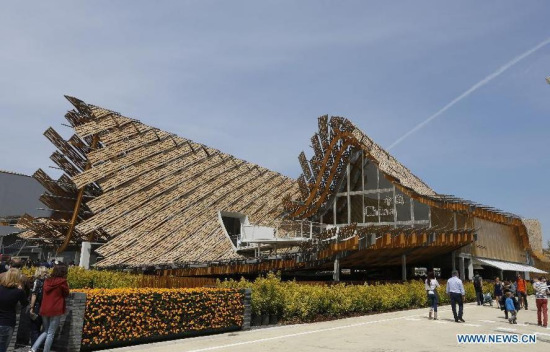
Photo taken on May 1, 2015 shows the China Pavilion at the Milan Expo 2015 in Milan, Italy. The Milan Expo will run until October 31 and is expected to attract over 20 million visitors. (Photo: Xinhua/Ye Pingfan)
Looking at the "wheat wave" inside the China Pavilion at the Milan Expo 2015, Magenson said this is an innovated architecture design with vivid dynamics, which reminds him of a visit to China years ago.
Magenson and his wife are from the United States, they came to Milan for a visit, particularly to see the world exposition here, the American told Xinhua.
To build the pavilion, Su Dan, a Chinese artist, has been traveling many times to and fro between Italy and China, tasked with the job of overseeing the first national pavilion that China has built outside its borders. It is based on the design proposal by the 48-year-old Tsinghua University scholar and his team.
"National pavilions at each world expo are the indicators of the latest development in architecture. They not only showcase one country's prowess in technology but also the evolution of its culture," said Su, the pavilion's design director.
The theme of the China Pavilion is "The Land of Hope". Surrounding the pavilion is a field of what looks like 30,000 stalks of wheat - to remind visitors of Chinese farming culture - that are actually shafts of LED lighting.
The pavilion is a perfect reflection of the Milan Expro's theme: "Feeding the Planet, Energy For Life", Su believed.
The building features many Chinese characteristics throughout its wooden structure, such as the interior bamboo roof panels. According to Su, the design concept is loosely based on I Ching, also known as The Classic of Changes or Book of Changes.
"In our building, the roof, shaped like a cresting ocean wave of opaque glass-like shingles, represents heaven, the wheat field is Earth and the exhibition that shows China's civilization is a reflection of human activity," he said.
Piero Galli, Expo Milano 2015 Event and Entertainment General Director, said that China has given an outstanding interpretation of sustainable nutrition.
"China has wanted to have a strong presence at Expo Milano 2015, not only through the China national pavilion - the second largest foreign self-built pavilion after the German one - but also with two corporate pavilions and many initiatives," he said.
Galli said the visit to China pavilion offers a "fascinating, interactive, recreational and joyful experience."
At the world expo in Milan, visitors will also learn the name "Seeds of China" from the China Corporate United Pavilion, which interprets the dream of a group of Chinese companies that seek to live the values of conservation of natural resources and food security.
In the exhibition spaces of the pavilion, the themes on display are "The Origin of Life", "The Power of Growth", "The Dream of the Seeds", "Light of Life", "Cycle of Life", "The Culinary Arts" and others, showing the path of growth and the role of the business community within the rapid development that China has enjoyed.
It is the first time that Chinese companies unite to take part in a Universal Exposition with their own pavilion.
Daniel Libeskind, the world-famous architect who has created the pavilion of Chinese real estate developer Vanke, said that China is a valuable source of inspiration.
Libeskind told Xinhua that he first of all appreciated Vanke as a company. "It is not just a company for profit, it is a company that has also an ethical and social idea, which is very important, that's why I work with Vanke," he said.
The Vanke Pavilion, he explained, is a complex idea inspired by ancient Chinese thinking and combining different elements from the Chinese philosophy and landscape to Vanke's mission and the Shitang theme, the Chinese social dining hall.
Libeskind said the pavilion, built with sustainable materials, is a celebration of Vanke and of China. "Chinese people have been called people of the dragon. I developed three-dimensional tiles that transform carbon dioxide in oxygen and self-cleaning," he said.
At the Milan Expo 2015, the three different China-related pavilions are separate but interconnected with each another, like three Chinese name cards for visitors from all over of the world.
















































